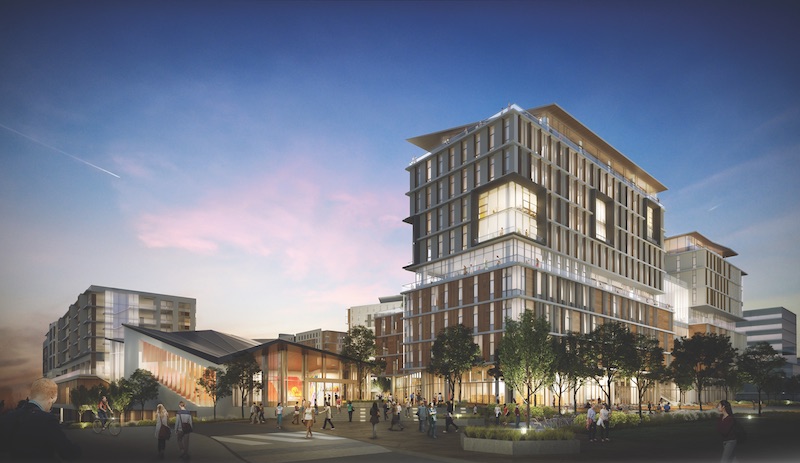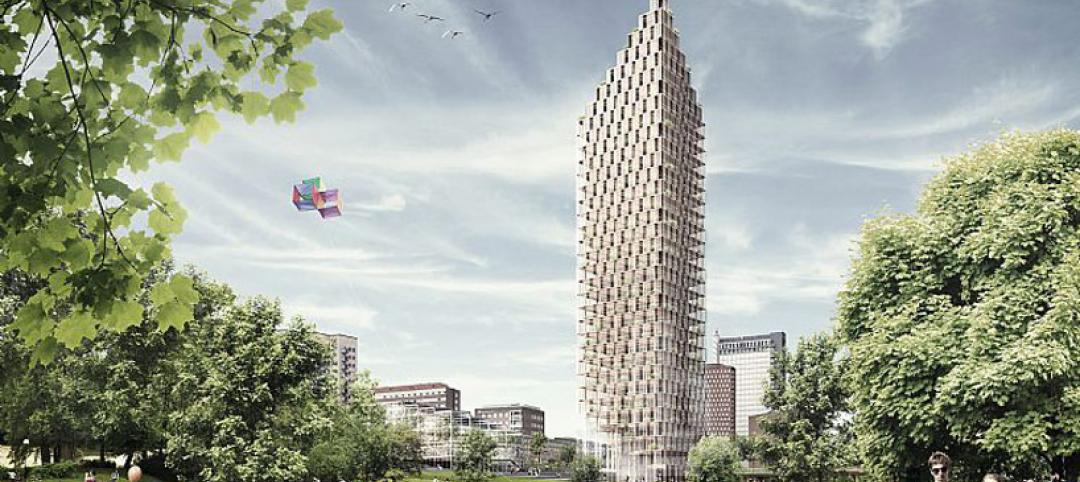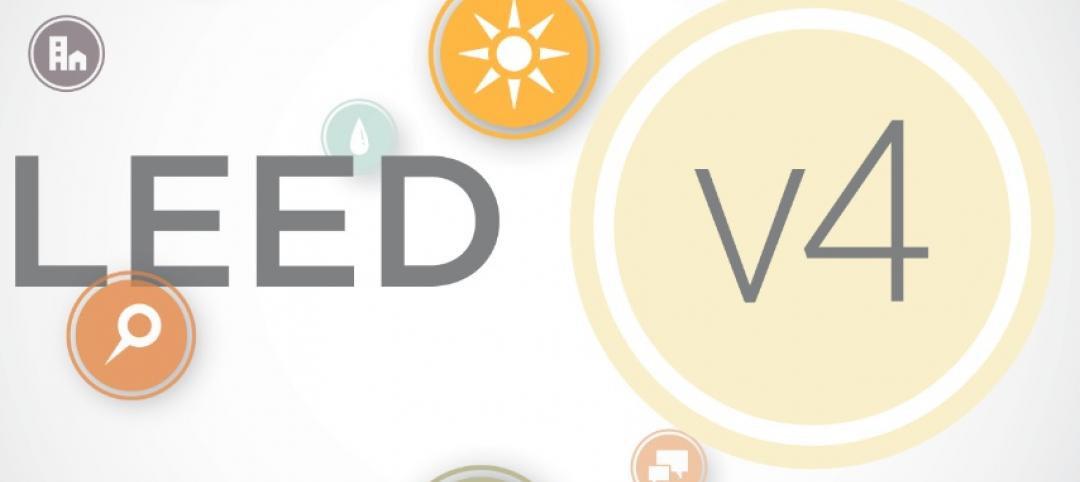Cities and counties around the country are taking sustainability to new heights—and architecture firms are helping them raise the stakes in green design. San Diego and New York are among a growing number of local jurisdictions that are expanding the scope of their energy- and water-use requirements for new construction. The County of San Diego has committed to making all new buildings achieve zero net energy—preferably to produce more energy than they consume through on-site energy generation.
In New York City, staff members at architectural firm FX Collaborative (formerly FXFowle) are actively involved in various task forces related to green building codes and policy. Lately, the focus has been on setting energy use intensity, or EUI, targets for buildings, as opposed to energy cost savings, which is the metric used by LEED and municipal energy codes, says Ilana Judah, AIA, OAQ, LEED AP BD+C, CPHD, FX Collaborative’s Principal and Director of Sustainability. The city recently passed a law that will grade a building’s performance and require the owner to post the grade in a highly
visible location.
Energy-efficiency requirements are getting tougher. Strategies that once were optional are now being incorporated into building and energy codes. Massachusetts now requires multifamily residential buildings in designated Green Communities to comply with higher HERs ratings, Energy Star certification v3.1, or Passive House certification PHIUS+ 2015.
See Also: Top 160 Green Building Architecture + AE Firms
Linda Toth, a Sustainability Specialist in Gensler’s Washington, D.C., office, says a growing number of jurisdictions in every climate zone have green-building mandates coming down the pike for net-zero and net-zero-capable projects. D.C. is currently working on plans to be one of the first municipalities to require net-zero energy for all new residential and commercial construction by 2026, as outlined in the District’s 2016 Clean Energy DC agenda.
Add to that Climate Ready DC, the District’s latest plan to adapt to changing climatic conditions that could produce dangerous heat waves, more severe storms, and drastic flooding that could impact the city’s many historic buildings as well as newer structures. Among the smart-building means to help achieve this goal: high-performing building enclosures, redundant energy and water systems, and correct siting of mechanical systems.
One new form of energy regulation is so-called solar carve-outs, which set specific goals for electricity generated from solar panels. According to the Database of State Incentives for Renewables & Efficiency (DSIRE, at bit.ly/2I5mXxu), 22 states and D.C. have set renewable portfolio standards with solar or distributed-generation provisions. The District of Columbia wants to generate the equivalent of 5% of its buildings’ energy consumption from solar by 2032.
NEW RATINGS SCHEMES SPROUTING UP
In today’s policy climate, “building green” extends well beyond reducing a structure’s carbon footprint. “Energy and water efficiency are great catalysts for larger conversations around sustainability and resilience,” says Benjamin Holsinger, a Sustainability and Wellness Consultant in Gensler’s Washington, D.C., office.
While LEED continues to be the most commonly used framework for green buildings, it’s no longer the only show in town. Design firms are finding that clients are starting to include newer rating systems like SITES, Envision, Fitwel, WELL, and Parksmart in their project requirements.
Last year, The Miller Hull Partnership, a Seattle-based architecture firm, led a so-called Progressive Design-Build team—Arup, KPFF Consulting Engineers, GGN (landscape architect), O’Brien & Company (sustainability consultant), and Mortenson Construction—on the University of Washington’s West Campus Utility Plant. The $35 million facility provides 4,500 tons of chiller capacity and six megawatts of emergency power; it can reach 10,500 tons of chiller capacity and 12 MW of emergency power without modifying the building.
The project achieved Envision Gold Certification from the Institute of Sustainable Infrastructure, the first Envision-certified project at the University of Washington and the first university building in the U.S. to be Envision-certified. Envision is an independent third-party rating system designed specifically to evaluate, grade, and recognize sustainable infrastructure projects.
PASSIVE MEASURES GAINING TRACTION
Clients are pressing their design firms to verify that buildings will perform as promised. To that end, FX Collaborative’s Judah is convinced that passive building practices could be “the future of green building.”
This possibility is already evident on certain academic campuses. In Maine, six of the eight commercial passive house projects that have been built or planned are at private schools. One of these institutions, Bowdoin College, was scheduled to start four residence halls—a total of 47,877 sf of construction—that will comply with Passive House performance requirements. Earlier this year, HKS Architects, in partnership with Clark Construction, broke ground on the University of California, San Diego’s Living and Learning Neighborhood at North Torrey Pines, a seven-building, 1.5-million-sf mixed-use complex. Its passive features range from operable windows for natural ventilation to a modular micro-aerobic digester that will process food waste into biogas and fertilizer for community gardens.
Clients are increasingly engaged with wellness in design, thanks in part to the rollout of LEED v4. They are also expressing greater familiarity with new rating systems, notably the WELL Building Standard, Fitwel, and the Living Building Challenge. They are seeking to go beyond ASHRAE’s minimal ventilation rates and to reduce their use of materials with chemicals of concern.
Gensler has created its proprietary WorkWell methodology. According to Gregory Plavcan, an Associate and Sustainability Specialist, WorkWell gives Gensler’s designers a greater insight on ways to incorporate a client organization’s core values into its wellness regimen.
Related Stories
| Aug 6, 2013
Australia’s first net zero office building features distinctive pixelated façade
Australia's first carbon neutral office building, featuring a distinctive pixelated façade, recently opened in Melbourne.
| Aug 2, 2013
Design of world’s tallest wood skyscraper would be more sustainable than steel alternative
Architecture firm C. F. Møller has proposed building the tallest wooden building in the world in Stockholm, Sweden.
| Jul 26, 2013
LEED V4 includes controversial cradle-to-cradle materials provision
Cradle to Cradle certification, a strict assessment of the environmental qualities of materials used in green buildings, is a controversial provision in LEED V4.
| Jul 17, 2013
CBRE recognizes nation's best green research projects
A rating system for comparative tenant energy use and a detailed evaluation of Energy Star energy management strategies are among the green research projects to be honored by commercial real estate giant CBRE Group.
| Jul 10, 2013
TED talk: Architect Michael Green on why we should build tomorrow's skyscrapers out of wood
In a newly posted TED talk, wood skyscraper expert Michael Green makes the case for building the next-generation of mid- and high-rise buildings out of wood.
| Jul 2, 2013
LEED v4 gets green light, will launch this fall
The U.S. Green Building Council membership has voted to adopt LEED v4, the next update to the world’s premier green building rating system.
| Jun 28, 2013
Calculating the ROI of building enclosure commissioning
A researcher at Lawrence Berkeley National Laboratory calls building enclosure commissioning “the single-most cost-effective strategy for reducing energy, costs, and greenhouse gas emissions in buildings today.”
| Jun 19, 2013
Florida is latest battleground over LEED standards centered on certified wood
A nationwide battle over forest certification standards continues to be played out nationally and in Florida with legislation passed this month.
| Jun 17, 2013
DOE launches database on energy performance of 60,000 buildings
The Energy Department today launched a new Buildings Performance Database, the largest free, publicly available database of residential and commercial building energy performance information.
| Jun 5, 2013
USGBC: Free LEED certification for projects in new markets
In an effort to accelerate sustainable development around the world, the U.S. Green Building Council is offering free LEED certification to the first projects to certify in the 112 countries where LEED has yet to take root.
















